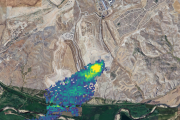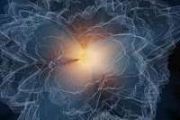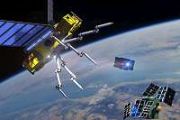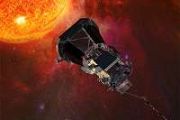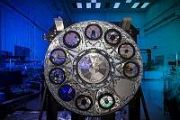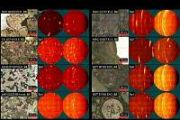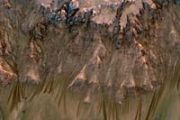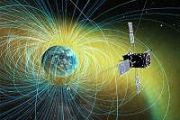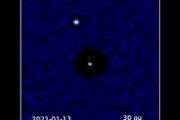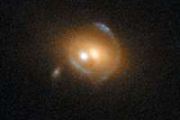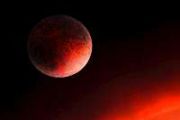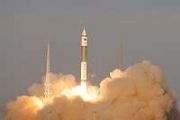
Copernical Team
Astrobee robots in 360° | Cosmic Kiss
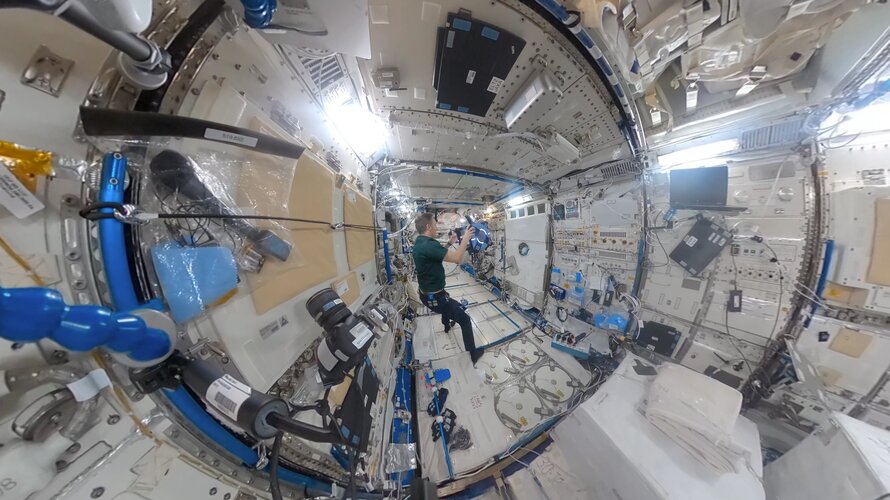 Video:
00:02:16
Video:
00:02:16
Join ESA astronaut Matthias Maurer inside Kibo, the Japanese laboratory module of the International Space Station in 360°, setting up Astrobee robotic free-flyers for the ReSWARM experiment, short for RElative Satellite sWArming and Robotic Maneuvering. The robotics demonstration tests autonomous microgravity motion planning and control for on-orbit assembly and coordinated motion.
Thus, this investigation aims to test coordination between multiple robots, robots and cargo, and robots and their operating environment as developers envision the future of autonomous robot operations in space.
Matthias was launched to the International Space Station on Crew Dragon Endurance as part of Crew-3 at 02:03
Bringing the Sun into the lab
 Why the Sun's corona reaches temperatures of several million degrees Celsius is one of the great mysteries of solar physics. A "hot" trail to explain this effect leads to a region of the solar atmosphere just below the corona, where sound waves and certain plasma waves travel at the same speed. In an experiment using the molten alkali metal rubidium and pulsed high magnetic fields, a team from t
Why the Sun's corona reaches temperatures of several million degrees Celsius is one of the great mysteries of solar physics. A "hot" trail to explain this effect leads to a region of the solar atmosphere just below the corona, where sound waves and certain plasma waves travel at the same speed. In an experiment using the molten alkali metal rubidium and pulsed high magnetic fields, a team from t No returning to climate of the past even with CO2 reduction
 While the entire world focuses on achieving carbon neutrality - zero carbon dioxide (CO2) emissions - a new research shows climate change in some regions is inevitable even if the already increased CO2 level is reduced. As CO2 decreases, the intertropical convergence zone (ITCZ) shifts southwards, which can trigger persistent El Nino conditions. El Nino refers to a phenomenon in which the sea su
While the entire world focuses on achieving carbon neutrality - zero carbon dioxide (CO2) emissions - a new research shows climate change in some regions is inevitable even if the already increased CO2 level is reduced. As CO2 decreases, the intertropical convergence zone (ITCZ) shifts southwards, which can trigger persistent El Nino conditions. El Nino refers to a phenomenon in which the sea su New year's mission to start new phase of exoplanet research
 A mission to one of the coldest and most remote places on earth will enable a new phase in the search for distant planetary systems. University of Birmingham PhD researcher Georgina Dransfield has travelled to the Franco-Italian Concordia Research Station in Antarctica, to oversee the installation of a new state-of-the-art camera at the ASTEP (Antarctic Search for Transiting ExoPlanets) telescop
A mission to one of the coldest and most remote places on earth will enable a new phase in the search for distant planetary systems. University of Birmingham PhD researcher Georgina Dransfield has travelled to the Franco-Italian Concordia Research Station in Antarctica, to oversee the installation of a new state-of-the-art camera at the ASTEP (Antarctic Search for Transiting ExoPlanets) telescop Sending Life to the Stars
 No longer solely in the realm of science fiction, the possibility of interstellar travel has appeared, tantalizingly, on the horizon. Although we may not see it in our lifetimes - at least not some real version of the fictional warp-speeding, hyperdriving, space-folding sort - we are having early conversations of how life could escape the tether of our solar system, using technology that is with
No longer solely in the realm of science fiction, the possibility of interstellar travel has appeared, tantalizingly, on the horizon. Although we may not see it in our lifetimes - at least not some real version of the fictional warp-speeding, hyperdriving, space-folding sort - we are having early conversations of how life could escape the tether of our solar system, using technology that is with Sol 3349: Ridges, Big and Small
 Another successful drive on Mars resulted in a dusty bedrock workspace with nodules and small raised ridges in front of the rover. Curiosity also has a view towards larger scale, dark, resistant ridges that we have noticed within the more subdued and lighter coloured, more typical bedrock in this area.
The science team decided to investigate the chemistry and texture of one of the small, r
Another successful drive on Mars resulted in a dusty bedrock workspace with nodules and small raised ridges in front of the rover. Curiosity also has a view towards larger scale, dark, resistant ridges that we have noticed within the more subdued and lighter coloured, more typical bedrock in this area.
The science team decided to investigate the chemistry and texture of one of the small, r Shouzhou XIII crew finishes cargo spacecraft, space station docking test
 The Shenzhou XIII astronauts in China's space station core module have completed the manual rendezvous and docking experiment with the Tianzhou 2 cargo craft, the China Manned Space Agency (CMSA) said Saturday.
At the beginning of the experiment, the astronauts in the core module teleoperated the Tianzhou 2 cargo craft to leave the front docking port of the core module's node cabin and mov
The Shenzhou XIII astronauts in China's space station core module have completed the manual rendezvous and docking experiment with the Tianzhou 2 cargo craft, the China Manned Space Agency (CMSA) said Saturday.
At the beginning of the experiment, the astronauts in the core module teleoperated the Tianzhou 2 cargo craft to leave the front docking port of the core module's node cabin and mov Russian rocket is in uncontrolled descent to Earth
 A Russian rocket is expected to re-enter Earth's atmosphere Wednesday in an uncontrolled descent.
Much of the rocket is expected to burn up as it plunges through the atmosphere, so there likely will not be major damage when it hits.
According to Russia's state-run TASS news agency, the Angara-A5 heavy-lift rocket was launched Dec. 27 to test the Persei booster.
The Europea
A Russian rocket is expected to re-enter Earth's atmosphere Wednesday in an uncontrolled descent.
Much of the rocket is expected to burn up as it plunges through the atmosphere, so there likely will not be major damage when it hits.
According to Russia's state-run TASS news agency, the Angara-A5 heavy-lift rocket was launched Dec. 27 to test the Persei booster.
The Europea Perseverance set to exit Seitah area
 While many reflect on the past and bid it farewell, there's a lot of exciting science to come in the next year. While many were enjoying the days between the Christmas and New Year holidays in the US, at JPL we were working to finish up sampling activities at Issole. We'll soon bid an Auld Lang Syne to the Seitah region.
As lead Mapping Specialist, I get enjoy looking at the road ahead for
While many reflect on the past and bid it farewell, there's a lot of exciting science to come in the next year. While many were enjoying the days between the Christmas and New Year holidays in the US, at JPL we were working to finish up sampling activities at Issole. We'll soon bid an Auld Lang Syne to the Seitah region.
As lead Mapping Specialist, I get enjoy looking at the road ahead for China's lunar rover travels over 1km on the moon
 China's Yutu 2 lunar rover has traveled more than 1 kilometer on the moon and is still working well, according to the China National Space Administration.
The administration said on Saturday that the distance traveled by the rover reached 1 km on Thursday evening. As of late that night, the robot had moved about 1,004 meters on the lunar soil.
It added that Yutu 2, the second Chinese
China's Yutu 2 lunar rover has traveled more than 1 kilometer on the moon and is still working well, according to the China National Space Administration.
The administration said on Saturday that the distance traveled by the rover reached 1 km on Thursday evening. As of late that night, the robot had moved about 1,004 meters on the lunar soil.
It added that Yutu 2, the second Chinese 









